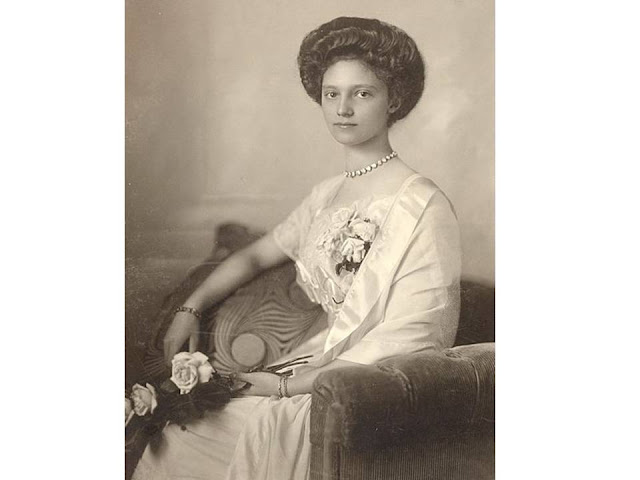 |
| A young Empress Zita. Image from Wikimedia Commons |
Empress Zita of Austria was born on May 9, 1892, at the Villa Pianore near Viareggio. She was the seventeenth of the 24 children of the prolific Robert I, the last reigning Duke of Parma. Her mother, the Infanta Maria Antonia of Portugal, was Robert's second wife.
In October 1911, Zita married Archduke Charles, who became the heir presumptive to the Hapsburg thrones after the assassination of his uncle Archduke Francis Ferdinand in 1914. Charles succeeded as Emperor of Austria and King of Hungary in 1916 with the death of his great-uncle, Emperor Francis Joseph. Amidst the chaos of World War I, the couple were crowned first in Vienna and, then, in Budapest. The “lavish ceremonies” faced the criticism of their subjects who called it “inappropriate” since the “privation caused by World War I was beginning to take effect.” (New York Times)
The new emperor attempted to negotiate peace between Austria and the Allies in the hope of saving the monarchy. Empress Zita asked her brother, Prince Sixtus of Bourbon-Parma, who was serving in the Belgian army, to contact the French President Raymond Poincare. Poincare, in turn, informed King George V of Britain of the Hapsburg emperor’s desire to seek peace. Alas, their attempts were foiled in 1918, “causing an uproar and rocking the Austrian-German alliance.” For her involvement, Empress Zita was labelled as the "spy of the Bourbons." (Washington Times)
 |
| Zita with Emperor Charles and seven of their eight children. Image from Wikimedia Commons |
In 1918, barely two years on the throne, Emperor Charles "relinquish[ed] every participation in the administration of the State,” but the Hapsburgs were eventually deposed and banished from Austria. Charles, Zita and their family went to Switzerland. After a failed attempt to regain the throne of Hungary in 1922, the family were moved by the Allies to Madeira where the former emperor died in 1922. Zita later claimed that “the latter attempt failed only because all the Hungarian railroad trains were so full of the beet crop that there was no transportation available to move the Hapsburg supporters to Budapest.”
Donning “nunlike mourning clothes” after the death of Charles, Zita never remarried but was left to raise her children. Together with her son, Crown Prince Otto, Zita emerged as a symbol of unity for the exiled family.
Zita and her children endured financial strain, despite the income from their private property in Austria and vineyard in Johannisberg on the Rhine Valley and voluntary collections. However, much of this money went to other exiled Habsburg relatives and former imperial officials, who frequently pleaded for help from their former empress.
At the height of World War II, the family fled to Quebec. Cut off from their European estates, the family faced hardship to the point that Zita had to make do with dandelion leaves and spinach for salad and dishes. After the war, she toured U.S. cities to promote humanitarian aid for Europe. In the early 1950s, she returned to Europe, where she settled at Zizers, which was a few hours' drive from the postwar home of Otto. “She would be seen taking little lonely walks near her home, a strange black-veiled figure wearing high-button shoes.” A devout Catholic, she lobbied for the canonization of her husband, the "Peace Emperor." She also involved herself in pre-World War II attempts to restore the Hapburgs on their throne.
The former Empress Zita died in Sizers on March 14,1989 at the ripe age of 96. She was interred at the Habsburg crypt in the Church of the Capuchin Friars in Vienna. In accordance with her will, her heart was taken and interred at the Habsburg family crypt at Muri Abbey in Swiss canton of Aargau. (Read more about Empress Zita here)

.png)





0 Comments